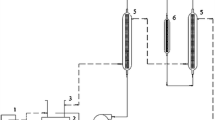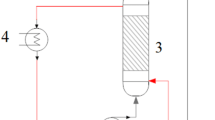Abstract
This study aimed to develop an optimal continuous procedure of immobilized hydroperoxide lyase (HPL)-catalyzed synthesis of hexanal. A central composite design was used to study the combined effect of substrate concentration and the residence time of the reactant on hexanal concentration. The optimum conditions for hexanal synthesis included a 13-HPOD concentration of 43.54 mM and a residence time of 60.99 min. The maximum hexanal concentration was 3560 ± 130 mg/L when 16 U of immobilized HPLwas used. Furthermore, the stability of immobilized HPL was significantly improved in the packed-bed reactor, as evidenced by the slowed enzyme inactivation and prolonged operation time. The immobilized HPL remained activity until 40 mL substrate solution flowed past the packed-bed reactor. The catalyst productivity of hexanal in the packed-bed reactor was 5.35 ± 0.34 mg/U, much higher than that in the batch stirred reactor. This study was greatly meaningful for providing a green method to the large-scale production of hexanal.





Similar content being viewed by others
References
Buchhaupt M, Guder JC, Etschmann MMW, Schrader J (2012) Synthesis of green note aroma compounds by biotransformation of fatty acids using yeast cells coexpressing lipoxygenase and hydroperoxide lyase. Appl Microbiol Biotechnol 93:159–168
Schrader J, Etschmann MM, Sell D, Hilmer JM, Rabenhorst J (2004) Applied biocatalysis for the synthesis of natural flavour compounds: current industrial processes and future prospects. Biotech Lett 26(6):463–472
Gigot C, Ongena M, Fauconnier M-L, Wathelet J-P, Jardin PD, Thonart P (2010) The lipoxygenase metabolic pathway in plants: potential for industrial production of natural green leaf volatiles. Biotechnol Agron Soc Environ 14:451–460
Fauconnier M-L, Marlier M (1996) An efficient procedure for the production of fatty acid hydroperoxides from hydrolyzed flax seed oil and soybean lipoxygenase. Biotechnol Techn 10(11):839–844
Noordermeer MA, Van Der Goot W, Van Kooij AJ, Veldsink JW, Veldink GA, Vliegenthart JFG (2002) Development of a biocatalytic process for the production of C6-aldehydes from vegetable oils by soybean lipoxygenase and recombinant hydroperoxide lyase. J Agric Food Chem 50:4270–4274
Xiong J, Kong X, Zhang C, Chen Y, Hua Y (2012) Production of (2E)-hexenal by a hydroperoxide lyase from Amaranthus tricolor and salt-adding steam distillation for the separation. Eur Food Res Technol 235:783–792
Cass BJ, Schade F, Robinson CW, Thompson JE, Legge RL (2000) Production of tomato flavor volatiles from a crude enzyme preparation using a hollow-fiber reactor. Biotechnol Bioeng 67(3):372–377
Fukushige H, Hildebrand DF (2005) Watermelon (Citrullus lanatus) hydroperoxide lyase greatly increases C6 aldehyde formation in transgenic leaves. J Agric Food Chem 53(6):2046–2051
Santiago-Gómez MP, Vergely C, Policar C, Nicaud JM, Belin JM, Rochette L (2007) Characterization of purified green bell pepper hydroperoxide lyase expressed by Yarrowia lipolytica: radicals detection during catalysis. Enzyme Microb Technol 41(1–2):13–18
Gargouri M, Drouet P, Legoy M-D (2004) Hydro-peroxide lyase activity in mint leaves volatile C6-aldehyde production from hydroperoxy-fatty acids. J Biotechnol 111:59–65
Rabetafika HN, Gigot C, Fauconnier M-L, Ongena M, Destain J, du Jardin P, Wathelet J-P, Thonart P (2008) Sugar beet leaves as new source of hydroperoxide lyase in a bioprocess producing green-note aldehydes. Biotechnol Lett 30:1115–1119
Németh AS, Márczy JS, Samu Z, Háger-Veress A, Szajáni B (2004) Biocatalytic production of 2(E)-hexenal from hydrolysed linseed oil. Enzyme Microb Technol 34:667–672
Suurmeijer CNSP, Pérez-Gilabert M, van Unen DJ, van der Hijden HTWM, Veldink GA, Vliegenthart JFG (2000) Purification, stabilization and characterization of tomato fatty acid hydroperoxide lyase. Phytochemistry 53:177–185
Brühlmann F, Bosijokovic B, Ullmann C, Auffray P, Fourage L, Wahler D (2013) Directed evolution of a 13-hydroperoxide lyase (CYP74B) for improved process performance. J Biotechnol 163:339–345
Akacha NB, Gargouri M (2009) Enzymatic synthesis of green notes with hydroperoxide-lyase from olive leaves and alcohol-dehydrogenase from yeast in liquid/gas reactor. Process Biochem 44:1122–1127
Marczy JS, Nemeth AS, Samu Z, Hager-Veress A, Szajani B (2002) Production of hexanal from hydrolyzed sunflower oil by lipoxygenase and hydroperoxid lyase enzymes. Biotechnol Lett 24:1673–1675
Bucholz K, Kasche V, Bornscheuer UT (2012) Biocatalysts and enzyme technology. Wiley-VCH, Weinheim, pp 1–606
Chang S-W, Shaw J-F, Yang C-K, Shieh C-J (2007) Optimal continuous biosynthesis of hexyl laurate by packed-bed bioreactor. Process Biochem 42:1362–1366
Royon D, Daz M, Ellenrieder G, Locatelli S (2007) Enzymatic production of biodiesel from cotton seed oil using t-butanol as a solvent. Bioresour Technol 98:648–653
Kotwal SM, Shankar V (2009) Immobilized invertase. Biotechnol Adv 27(3):11–22
Long Z, Kong X, Zhang C, Jiang B, Hua Y (2010) Stability of hydroperoxide lyase activity from Amaranthus tricolor (Amaranthus mangostanus L.) leaves: influence of selected additives. J Sci Food Agric 90:729–734
Liu Q, Hua Y, Kong X, Zhang C, Chen Y (2013) Covalent immobilization of hydroperoxide lyase on chitosan hybrid hydrogels and production of hexanal by immobilized enzyme. J Mol Catal B Enzym 95:89–98
Vick BA (1991) A spectrophotometric assay for hydroperoxide lyase. Lipids 26:315–320
Piao J, Kobayashi T, Adach S, Nakanishi K, Matsuno R (2004) Continuous synthesis of lauroyl or oleoyl erythritol by a packed-bed reactor with an immobilized lipase. Process Biochem 39:681–686
Su E, Wei D (2014) Production of fatty acid butyl esters using the low cost naturally immobilized Carica papaya lipase. J Agric Food Chem 62:6375–6381
Tiwari AK, Kumar A, Raheman (2007) Biodiesel production from jatropha oil (Jatropha curcas) with high free fatty acids: an optimized process. Biomass Bioenergy 31:569–575
Montgomery DC (2001) Design and analysis of experiments, 5th edn. Wiley, New Work
Halim SFA, Kamaruddin AH, Fernando WJN (2009) Continuous biosynthesis of biodiesel from waste cooking palm oil in a packed-bed reactor: optimization using response surface methodology (RSM) and mass transfer studies. Bioresour Technol 100:710–716
Beg Q, Sahai V, Gupta R (2003) Statistical media optimization and alkaline protease production from Bacillus mojavensis in bioreactor. Process Biochem 39:203–209
Schade F, Thompson JE, Legge RL (2003) Use of a plant-derived enzyme template for the production of the green-note volatile hexanal. Biotechnol Bioeng 3(84):265–273
Nie K, Xie F, Wang F, Tan T (2006) Lipase catalyzed methanolysis to produce biodiesel: optimization of the biodiesel production. J Mol Catal B Enzym 43:142–147
Zanin GM, Moraes FF (2004) Enzimas como Agentes Biotecnológicos, 4th edn. Legis Summa, cap, Ribeirão Preto, pp 35–85
Laudani CG, Habulin M, Knez Z, Porta CD, Reverchon E (2007) Immobilized lipase-mediated long-chain fatty acid esterification in dense carbon dioxide: bench-scale packed-bed reactor study. J Supercrit Fluids 41:74–81
Yadav M, Srivastva N, Singh RS, Upadhyay SN, Dubey SK (2014) Biodegradation of chlorpyrifos by Pseudomonas sp. in a continuous packed-bed bioreactor. Bioresour Technol 165:265–269
Gigot C, Ongena M, Fauconnier M-L, Muhovski Y, Wathelet J-P, du Jardin P, Thonart P (2012) Optimization and scaling up of a biotechnological synthesis of natural green leaf volatiles using Beta vulgaris hydroperoxide lyase. Process Biochem 47:2547–2551
Author information
Authors and Affiliations
Corresponding author
Rights and permissions
About this article
Cite this article
Liu, Q., Hua, Y. Continuous synthesis of hexanal by immobilized hydroperoxide lyase in packed-bed reactor. Bioprocess Biosyst Eng 38, 2439–2449 (2015). https://doi.org/10.1007/s00449-015-1481-9
Received:
Accepted:
Published:
Issue Date:
DOI: https://doi.org/10.1007/s00449-015-1481-9




